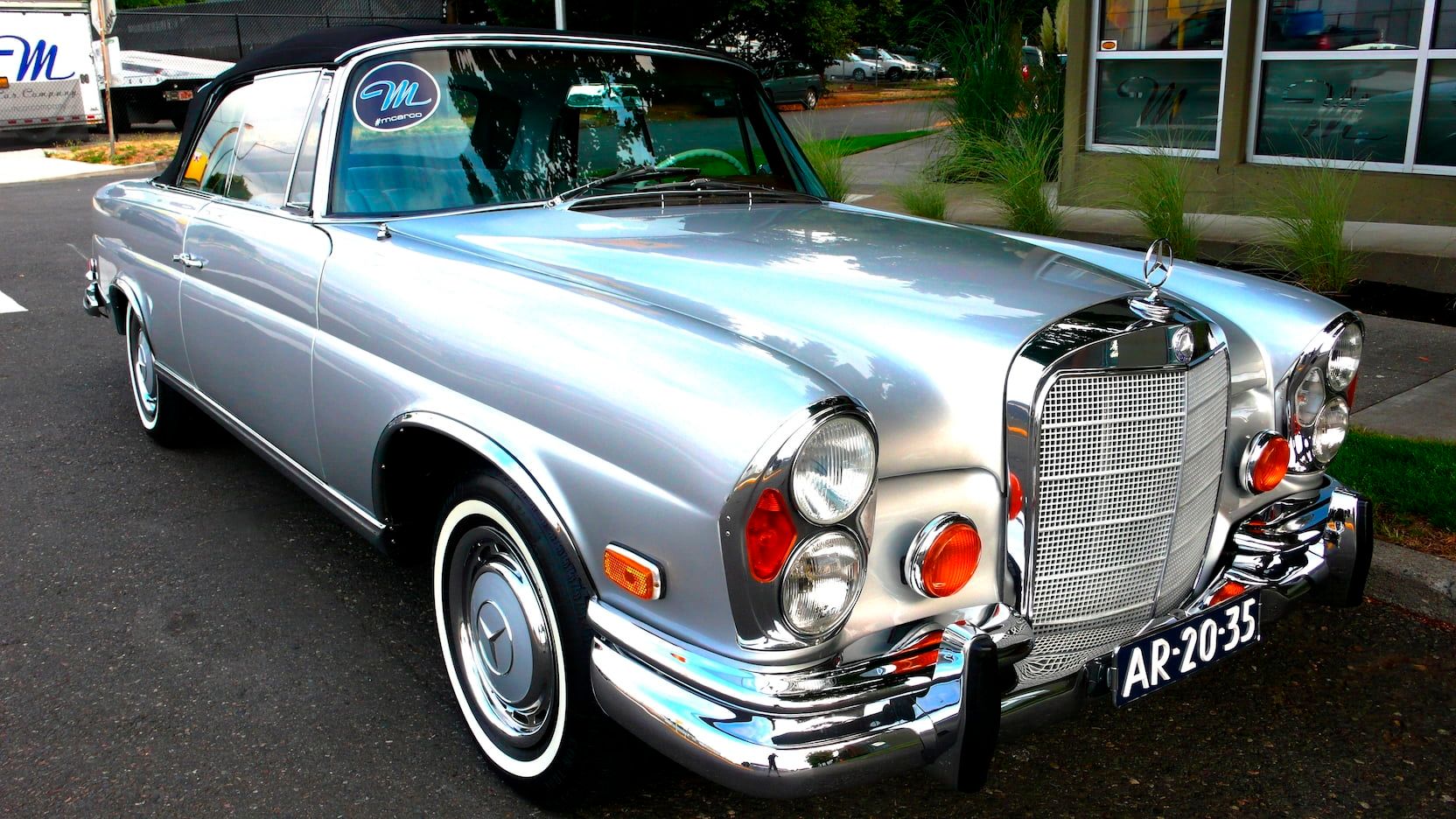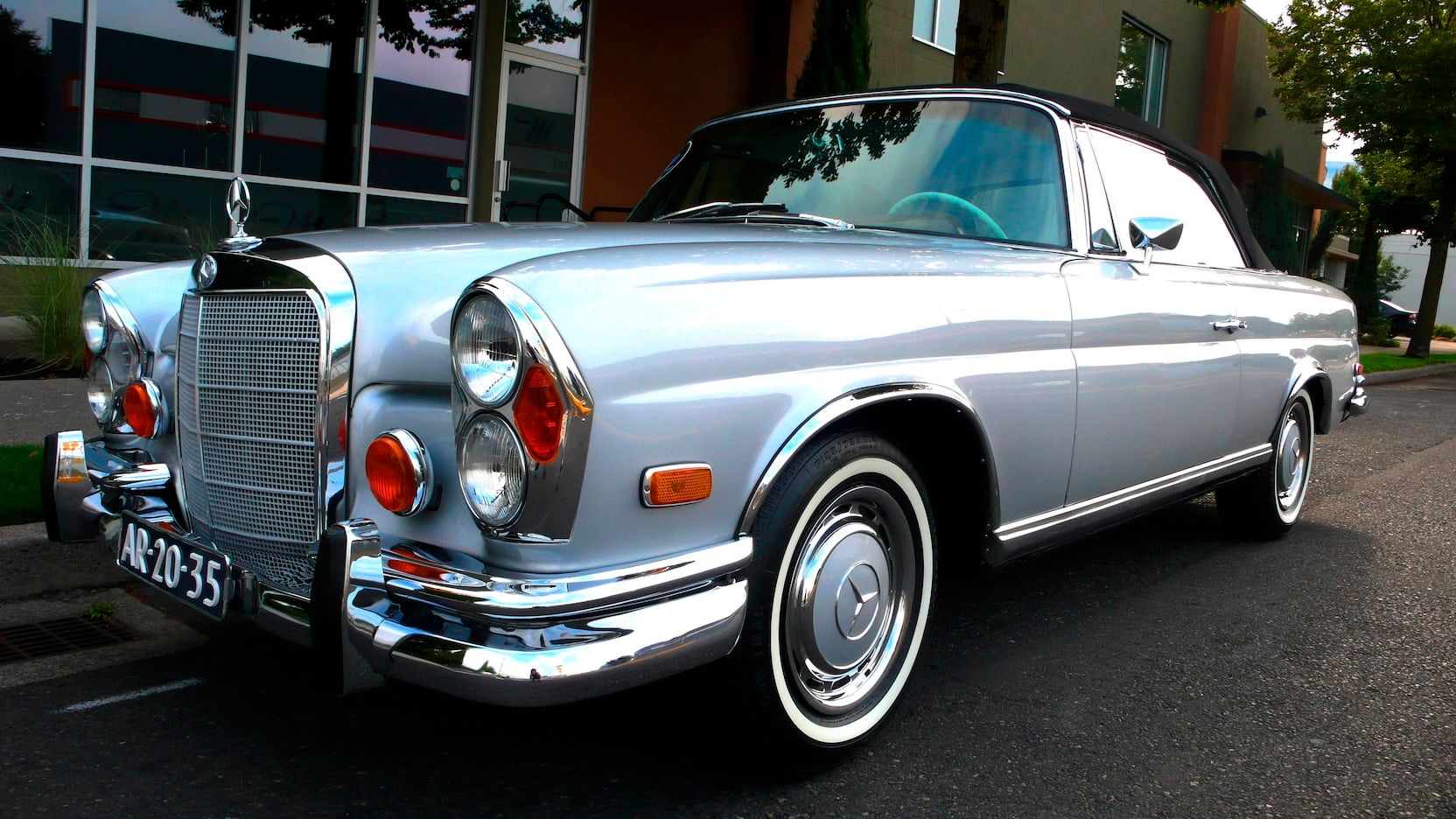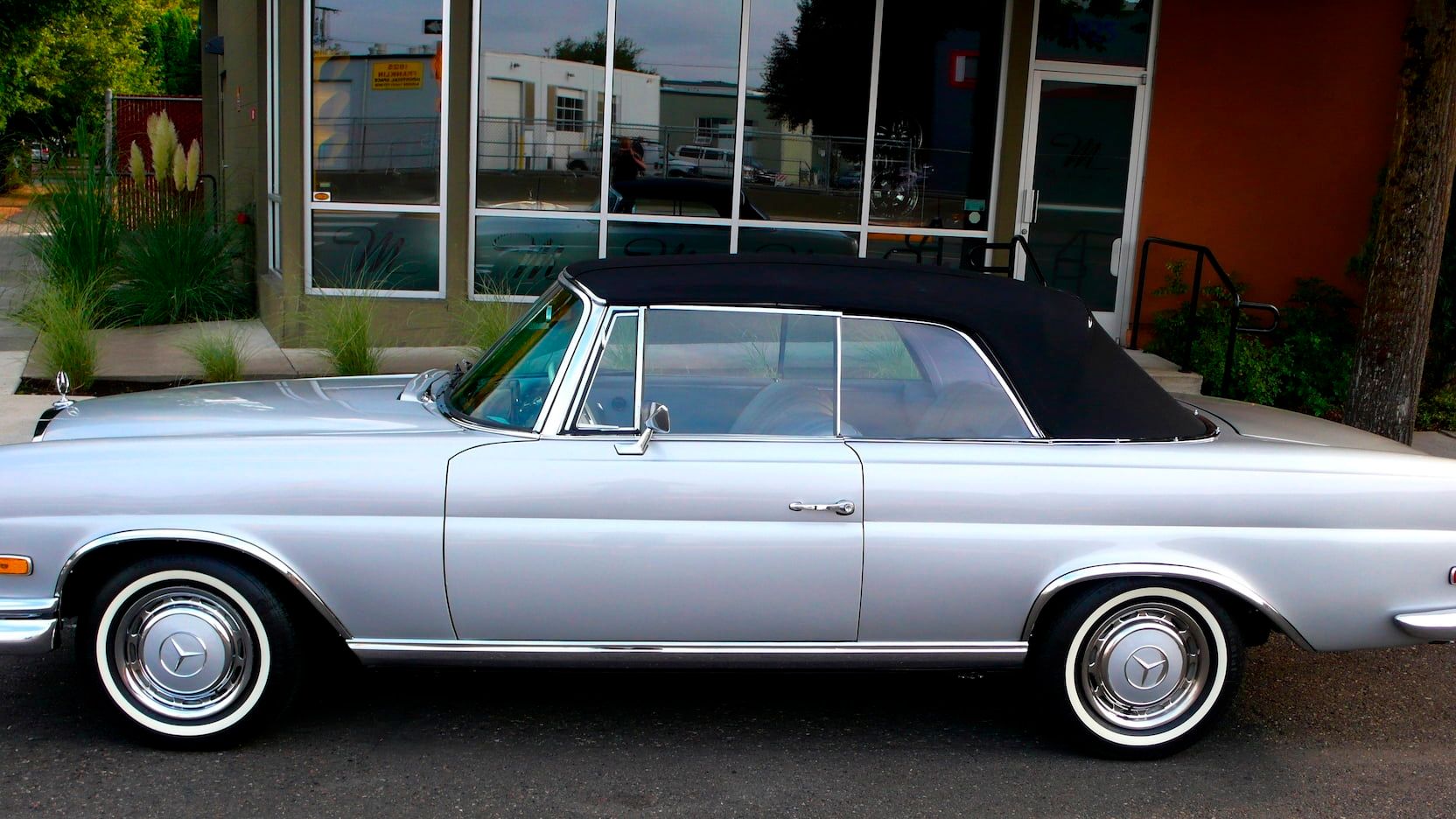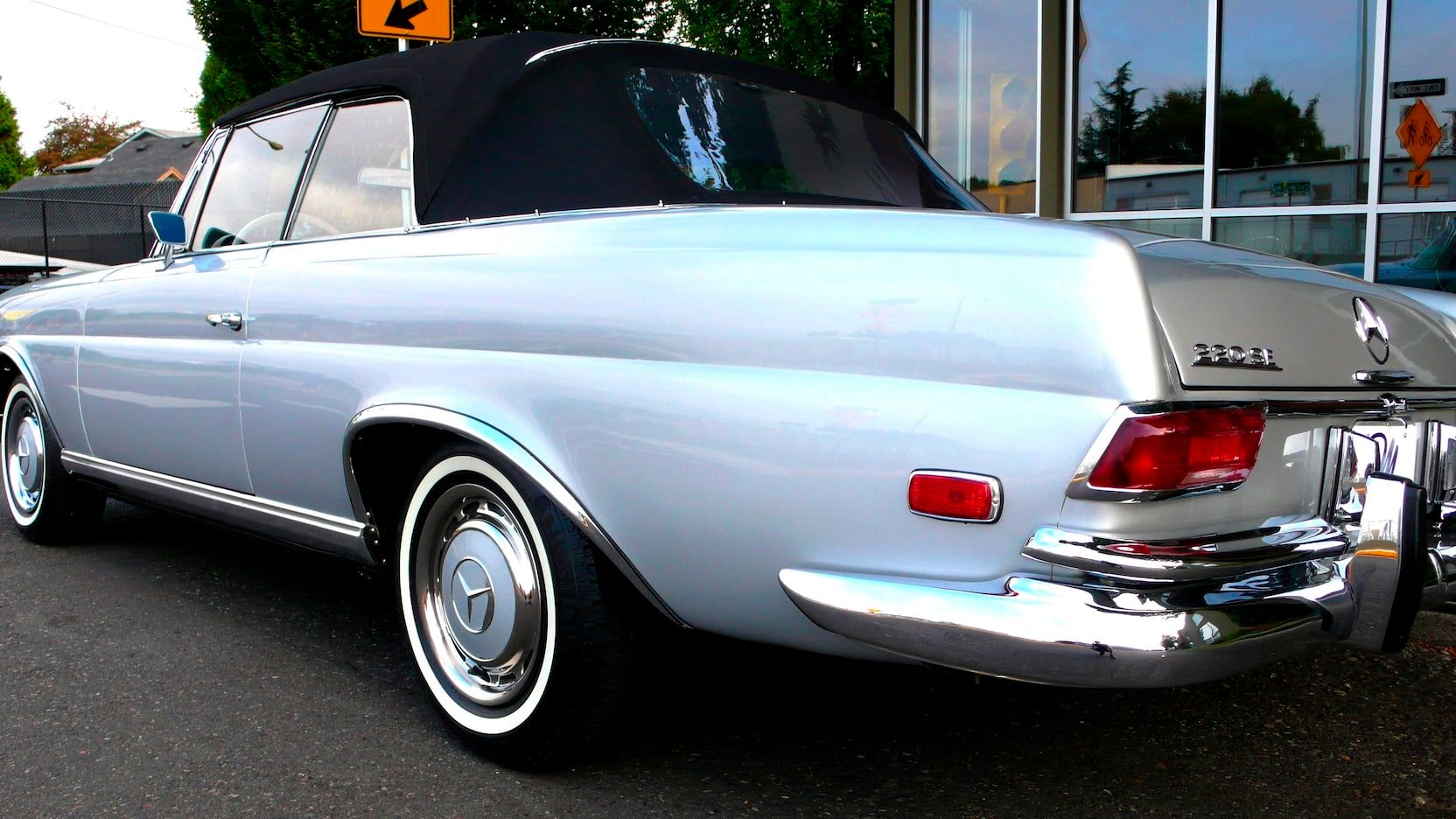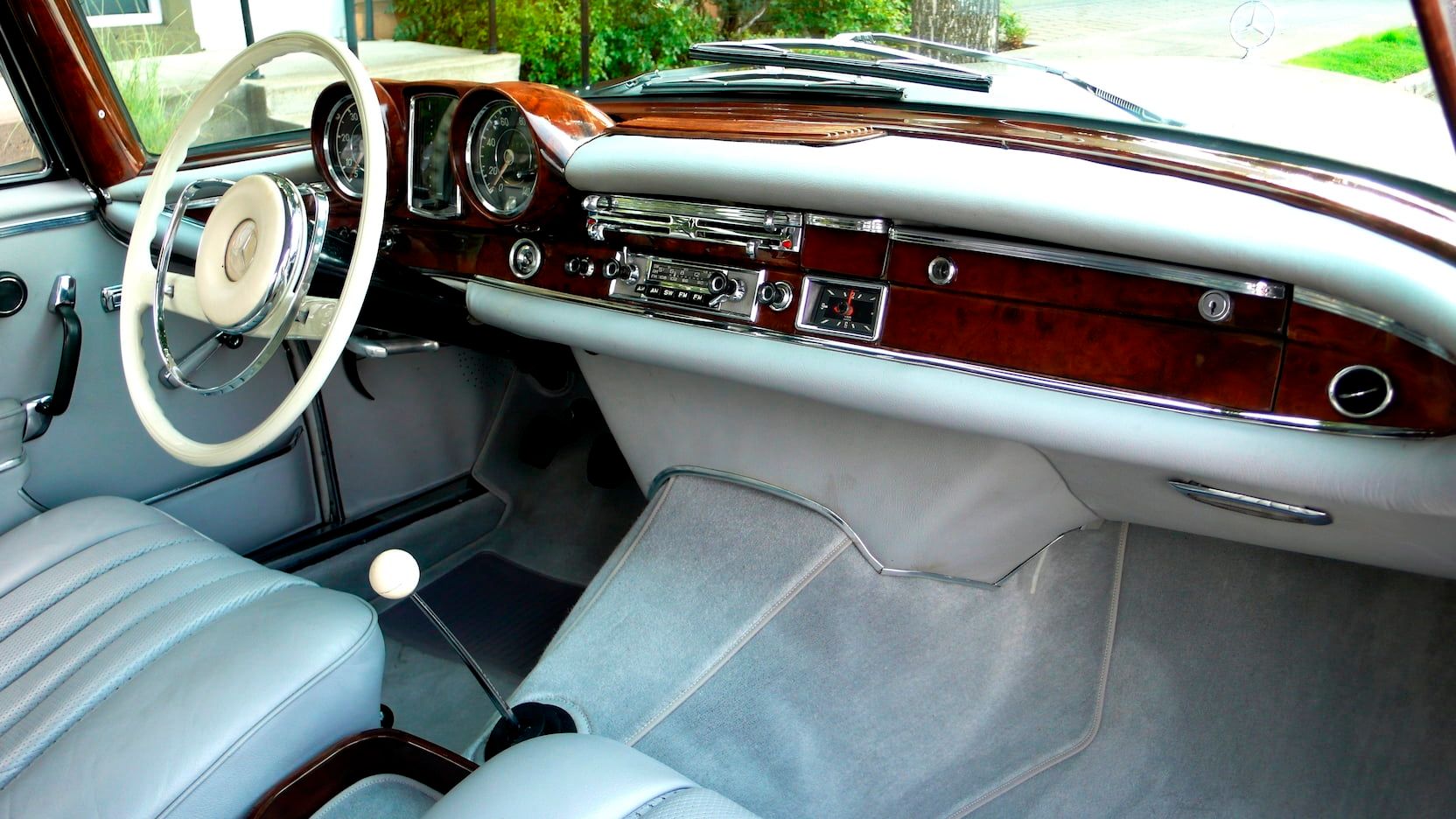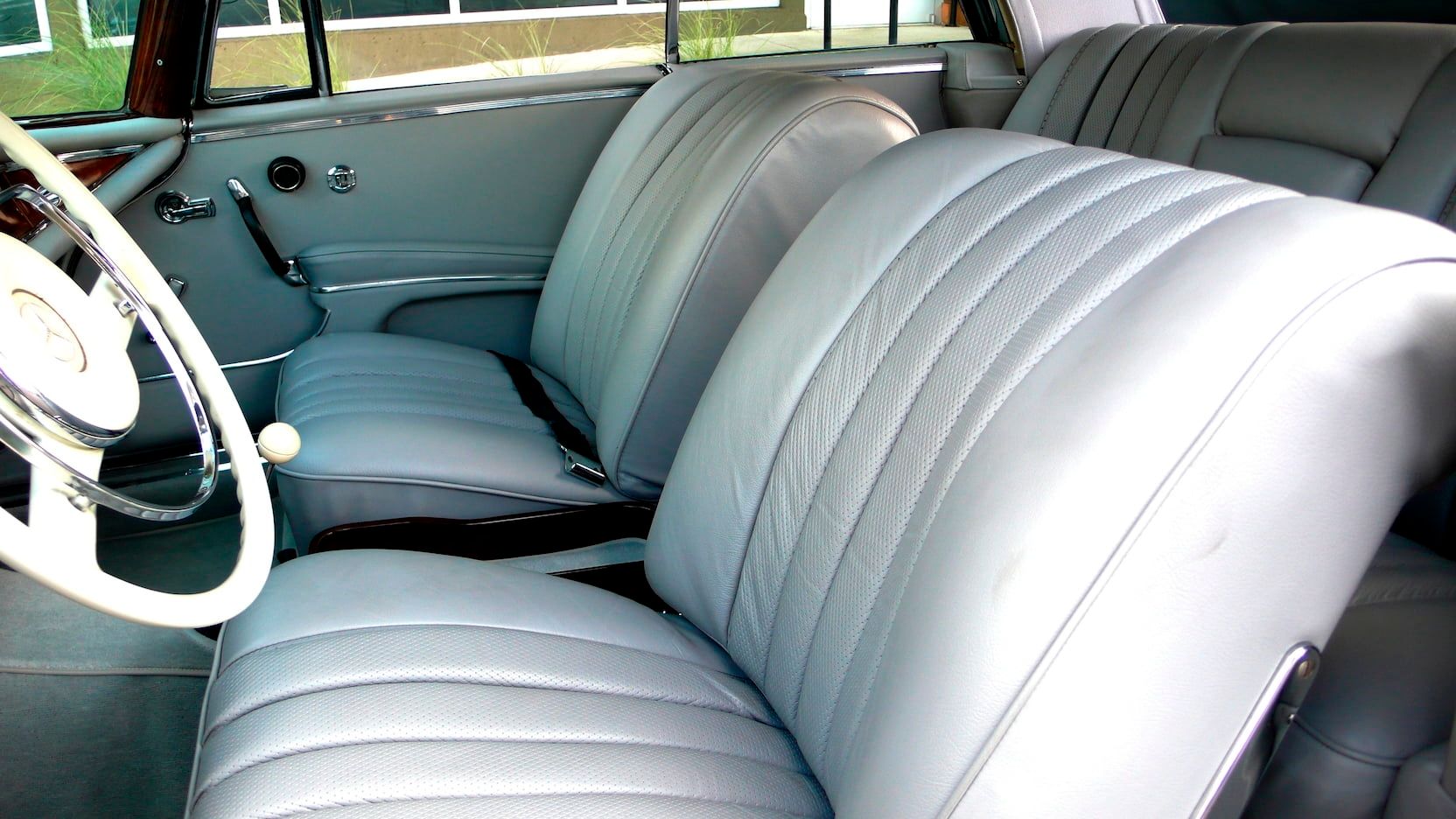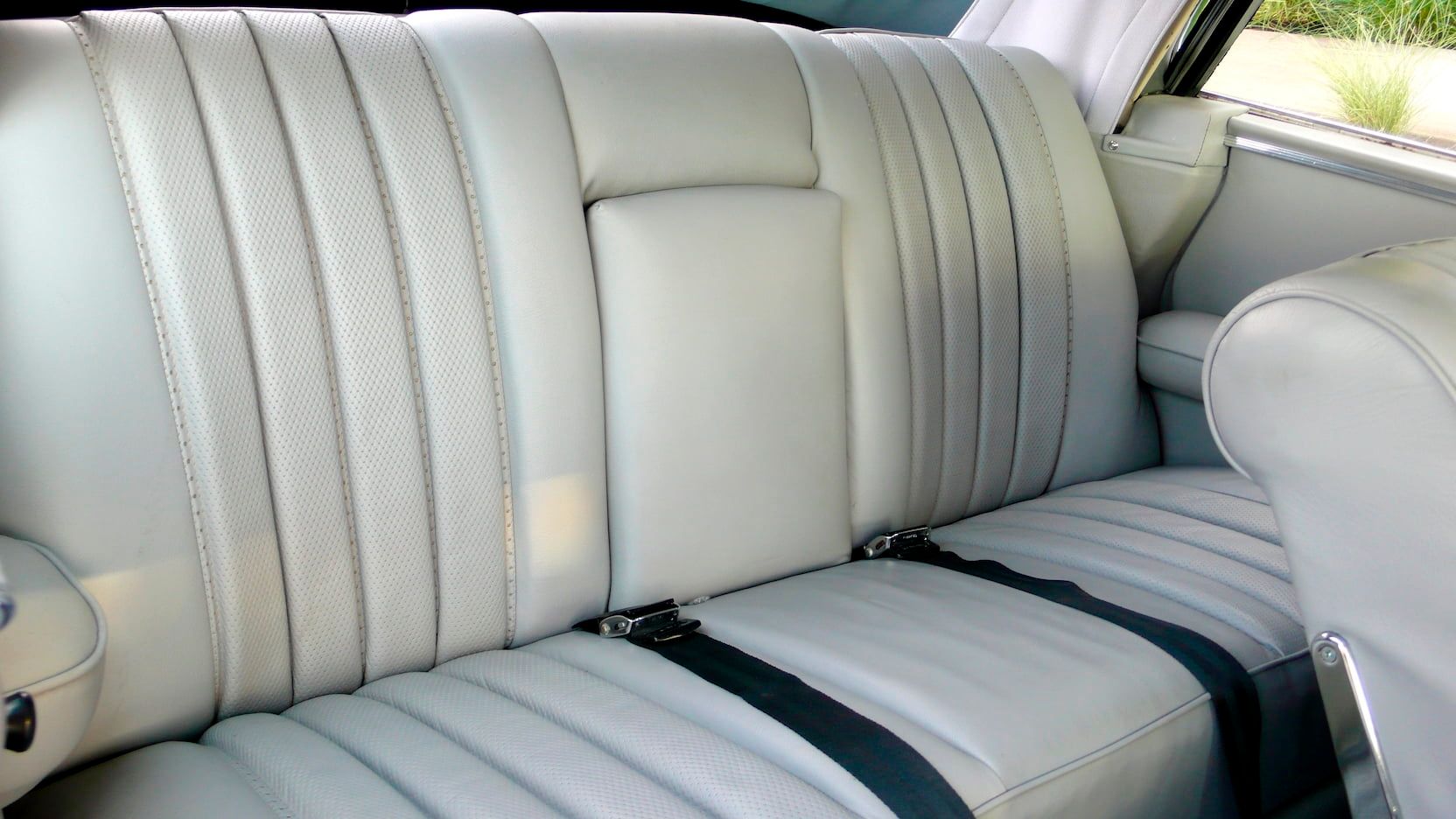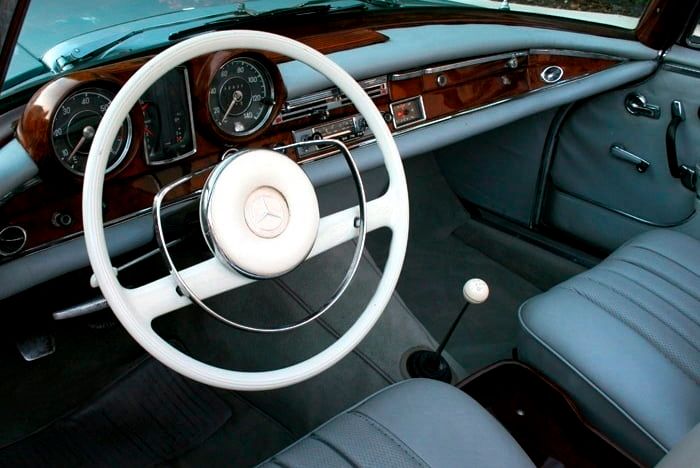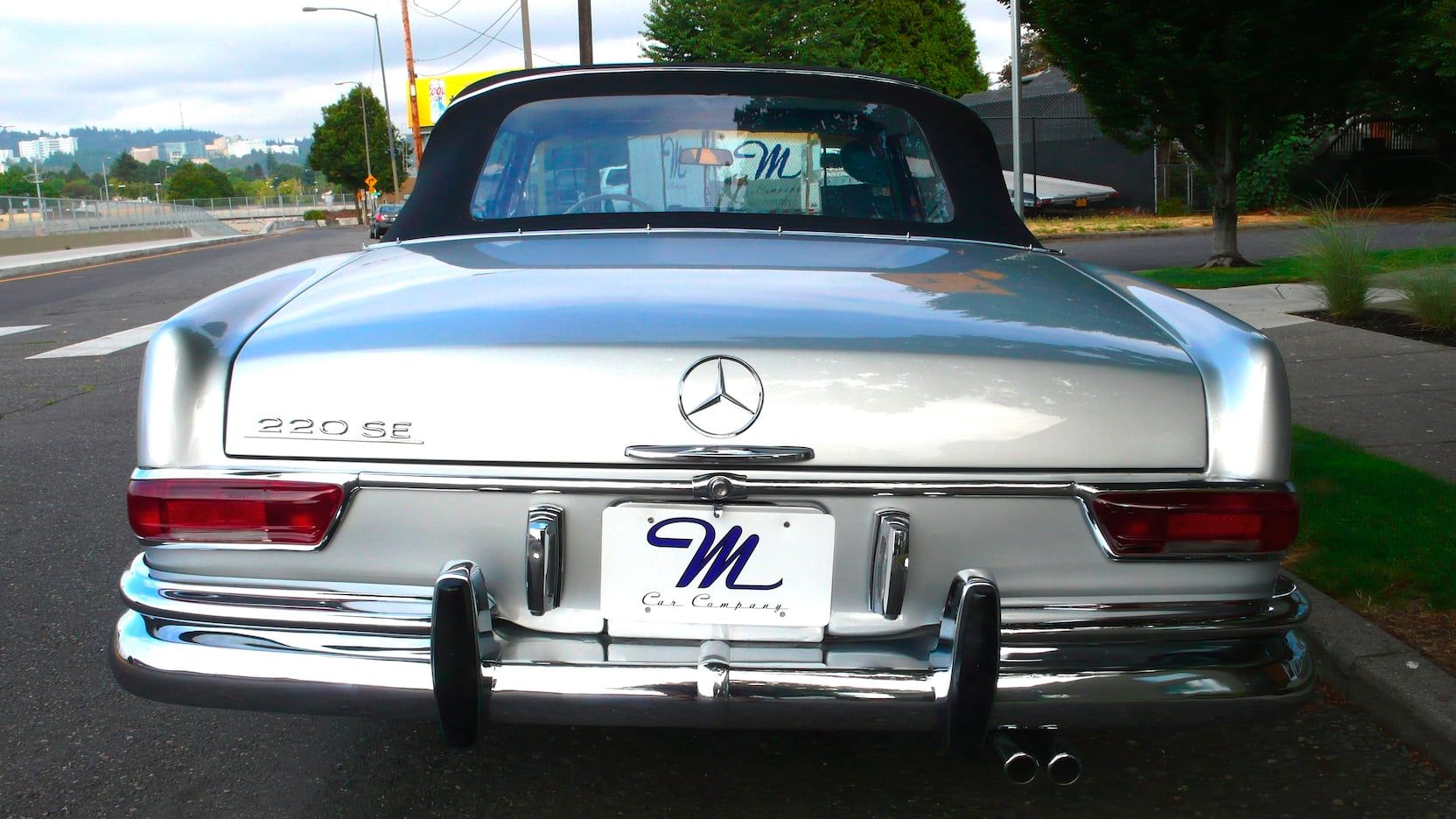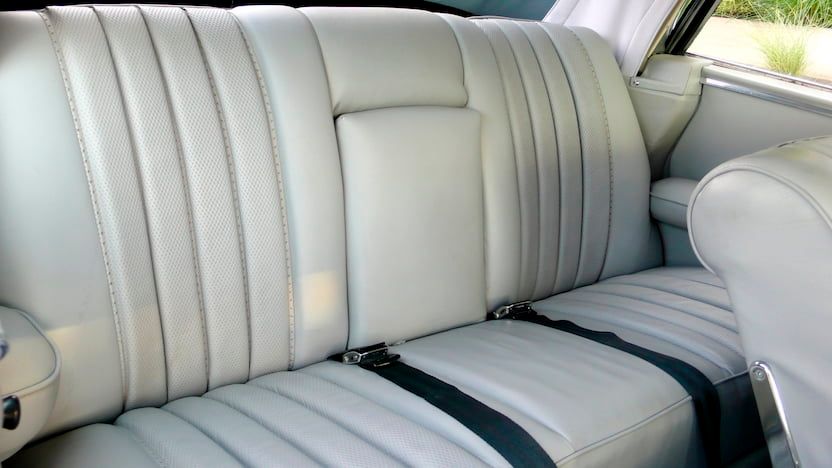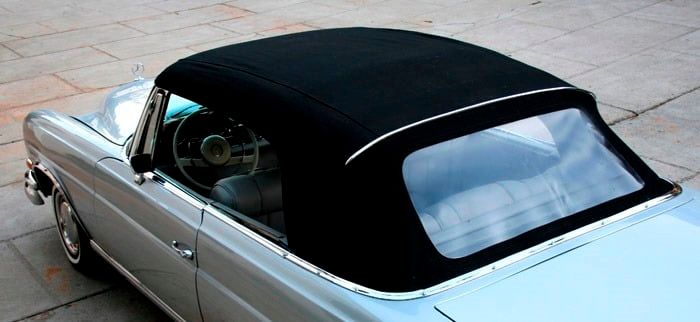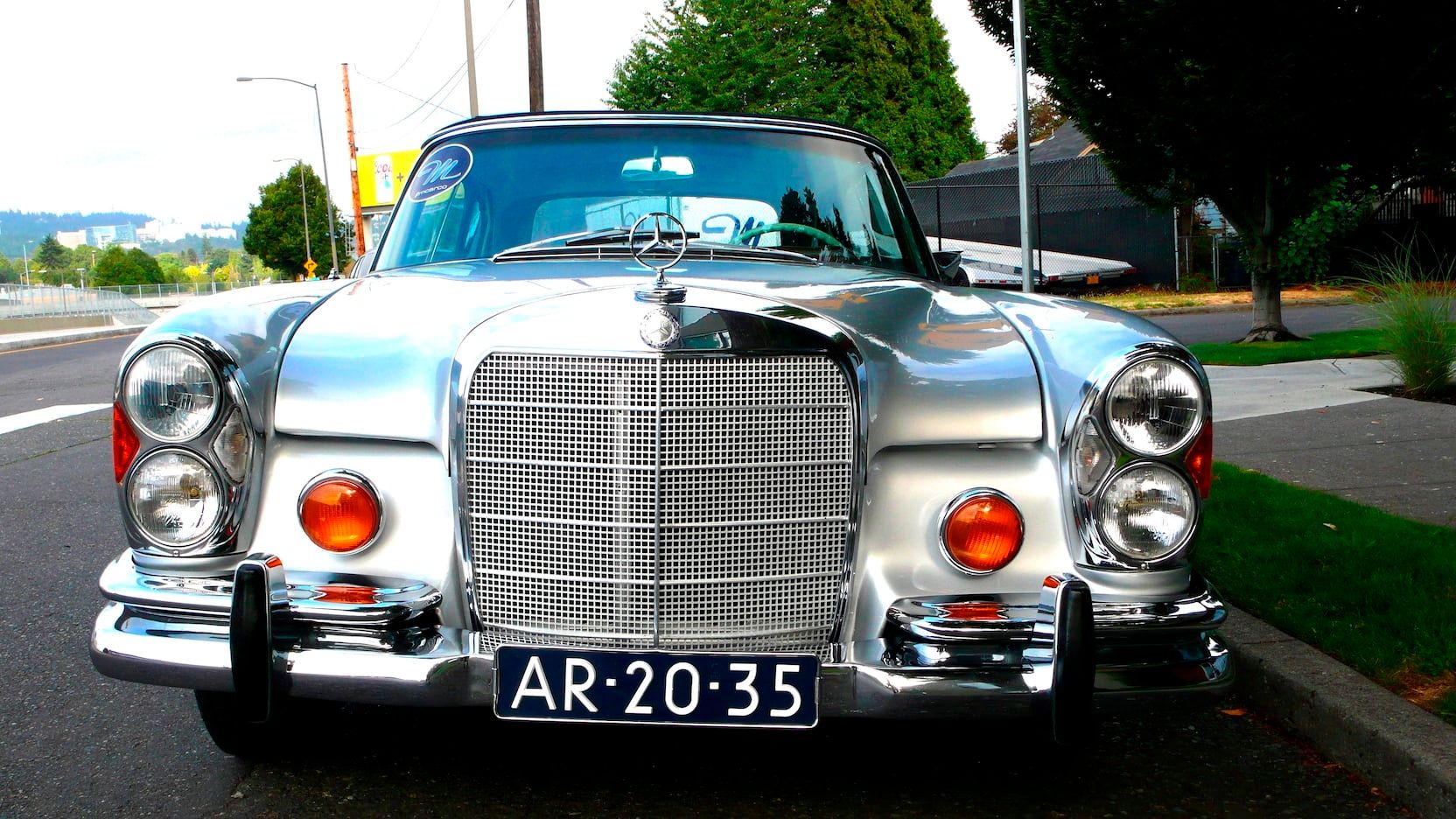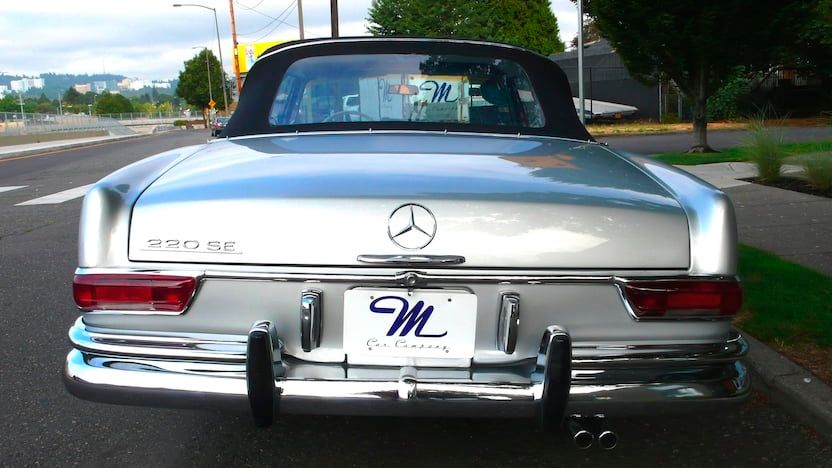The Mercedes-Benz 220SE Cabriolet, part of the W111 family of models, debuted in 1961 as a full-size executive open-top model that replaced the W128 220SE which was still based on the antiquated 'Ponton' design. The new model featured a more sharp-cornered design that has endured as one of Mercedes' finest over the years.
The W111 series debuted in 1959 at the Frankfurt Auto Show where Mercedes-Benz unveiled the four-door sedan body style which quickly gained the 'Heckflosse' nickname, which stands for 'Fintail' in English. The nickname emerged thanks to the car's stylized fins that rose at the rear of the car, a design cue aimed at the American clientele.
The Cabriolet version followed a couple of years later after the production cycle of the Ponton-based W128 Cabriolet ended. The two-door car had a soft top and exuded a sort of refined beauty that has become almost synonym with '60s Mercedes-Benz models. The W111 is considered part of the S-Class lineage along with the deluxe W112 that featured bigger engines and more amenities onboard.
1963 Mercedes-Benz 220SE Cabriolet
- Make: Array
- Model: 1963 Mercedes-Benz 220SE Cabriolet
- [do not use] Vehicle Model: Array
1963 Mercedes-Benz 220SE Cabriolet Exterior
The Mercedes W111 series, also known as the Mercedes 220, was a clear aesthetic departure from the popular 'Ponton' family that spawned a variety of body styles, and multiple wheelbases, as Mercedes became accustomed to the unibody construction.
The W111 was a car designed to be safer than its predecessor as well as offer a larger palette of creature comforts. It brought the now-classic twin-headlamp vertical headlights, the generous rectangular grille as the centerpiece of the front fascia and the then-popular wrap-around windscreen. It also had narrower horizontally-mounted taillights that were akin to those that were present on the W113 SL model, nicknamed 'Pagoda'.
The Cabriolet and Coupe versions arrived in 1961 with the open-top iteration being unveiled at that year's Frankfurt Auto Show. Mercedes-Benz decided to keep the design almost identical between the four-door and the two-door models to enforce brand image. Earlier design ideas for the coupe show that Mercedes originally toyed with the idea of a narrower horizontal grille that would set it apart from its brethren. Such a grille only ended up on the flagship sports car of the brand, the SL.
The fenders end abruptly with the vertically-mounted headlights. The two headlamps positioned one on top of the other, are surrounded by buckets of chrome. There are two extra lights on either side in between the two headlamps, the one to the outside being the indicator. Besides the indicator, there are also two more round, orange, lights attached to the front fascia. On some models, the extra lights have a transparent cover. The difference stems from the market in which the car ended up being sold in.
The chromed bumper itself is thick, featuring an extra element on top of the main bumper around the corners of the car.
From the side, you'll notice the chromed lining along the lower bodywork, including the teardrop-shaped wheel arches. The car is fitted with a chrome-framed wraparound windshield, although not as curved as the ones that can be seen on late '50s or early 60s American cars. The car only comes with one exterior mirror for the driver.
Along the side of the 220SE, there's a deep design line that runs from the front, level with the indicators, all the way to the back, ending just above the taillights. On some 220SE models, this was further highlighted with a chromed bar, but this example we see here lacks that aesthetic element.
At the back, the taillights encircle the rear corners of the car. They are narrow and rather small in size, much less imposing compared to the giant headlights. A chromed bar connects the top inner edge of the taillights.
You'll notice that the coupe and the cabriolet all but lack the tailfins that were the cause for the car's nickname. Basically, the rear fenders just slightly perk up without any chromed ornamentation at the tail end. This particular example has the Mercedes-Benz logo on the trunk as well as the model designation spelled out letter by letter in the left lower corner of the trunk. It also has two exhaust pipes sticking out on the passenger's side.
1963 Mercedes-Benz 220SE Cabriolet Exterior Dimensions:
|
Wheelbase: |
108.27 inches |
|
Length: |
192.13 inches |
|
Width: |
72.64 inches |
|
Height: |
56.89 inches |
1963 Mercedes-Benz 220SE Cabriolet Interior
The interior of the Mercedes-Benz 220SE is as lavish as you'd expect for a car that cost back in 1962 almost $80,000 in today's money. Granted, you'll find that a modern S-Class Coupe will set you back a lot more, but cars were cheaper back in the day. Anyway, the 220SE Cabriolet offered more for its five occupants than the four-door sedan version.
The dashboard tastefully combines wood with leather. The center panel of the dash, as long as gauge cluster is wooden with more wood adding up on top of the dash towards the windshield and on the A-pillar. Leather upholstery covers everything in between and you'll also find a few chromed bars gracing the interior premises.
The steering wheel is painted white, which was in fashion back in the early '60s, and features a smaller half-wounded chromed steering wheel attached to the central element and the steering's two spokes. Behind it there's the raised gauge cluster covered in wood which is dominated by the two round dials and the vertical dials in the middle. The tachometer is on the left while the odometer sits on the right with the fuel level, and oil and water meters sandwiched between.
The gear shifter sticks right out of the transmission tunnel.
Looking at the car's interior now, especially the example we have here, a 1963 model year 220SE Cabriolet, you can tell that even with the sort of uneven fitment of the glovebox, that the car was built to high standards - or as high as they were over 50 years ago.
1963 Mercedes-Benz 220SE Cabriolet Drivetrain
The 220SE Cabriolet, as well as the fixed-head 2-door model, came with the 2.2-liter M127 SOHC inline-6 naturally-aspirated engine. It developed 120 horsepower at 4,800 rpm and 139 pound-feet of torque at exactly the same rpm which is not something you see every day. This longitudinally-mounted 12-valve water-cooled unit had a bore of 3.15 inches and a stroke of 2.83 inches. It featured Bosch fuel injection and wet sump lubrication, as was the norm back then.
The 220SE Cabriolet was actually the model that had the smallest engine in the range. At the time, you could also get a 250SE Cabriolet which, as you'll easily guess, was powered by the M129 2.5-liter 6-cylinder engine which developed 150 horsepower. Less than 1,000 cars were fitted with that niche engine. Then there was the 280SE Cabriolet with the M130 2.8-liter inline-6 which had 10 horsepower over the M129. Finally, in late 1969, Mercedes launched the range-topping 280SE 3.5 Cabriolet powered by the M116 3.5-liter V-8 engine which put out 200 horsepower. It may not seem like much but remember that it was the early '60s and the car only weighed 3329 pounds, not much for a full-size 2-door model.
While Mercedes-Benz offered beefier engines, they also sort of attended to the suspension and other components to firm up the ride of the more potent W111 Cabriolets. Granted, it already came with coil springs on all four corners but the double-wishbone setup was only present up front. At the back, there was a swinging axle with a torsion bar. Steering was by recirculating ball while stopping power was offered by discs on the front axle and drums at the back end. On later models, the front suspension was changed and it featured unequal length A-arms with coil springs and a sway bar.
1963 Mercedes-Benz 220SE Cabriolet Specifications:
|
Engine: |
M127 V longitudinally-mounted naturally-aspirated 12-valve inline-6 2.2-liter engine |
|
Output: |
120 horsepower at 4,800 rpm |
|
Torque |
139 pound-feet of torque at 4,800 rpm |
|
Bore x stroke: |
3.15 inches x 2.83 inches |
|
Compression ratio: |
8.70:1 |
|
Gearbox: |
4-speed manual |
|
Brakes: |
Discs at the front and drums at the back |
|
Suspension: |
Coil springs and double wishbones up front and coil springs connected to a swinging axle with torsion bar at the rear. |
|
Steering: |
recirculating ball |
1963 Mercedes-Benz 220SE Cabriolet Pricing
Find a time machine and travel back to the year 1963. Then go to a Mercedes-Benz dealership and ask for an entry-level 220SE Cabriolet. You'd then have to hand over $9,650 to buy one. Adjusted for inflation that's about $78,000 today. That doesn't sound like much for a car as classy and dependable as this evergreen Merc and it really isn't.
You'll be pleased to know, though, that unlike other luxury cars from that period, this Mercedes-Benz isn't particularly rare nor particularly expensive. In fact, the 220SE has depreciated over time and you can now find a well-maintained example for somewhere between $60,000 and $70,000. The car we see in the pictures is actually yet to sell. It will cross the block during the upcoming Mecum auction that will take place in Las Vegas, Nevada, between November the 15th and November the 17th. If, for whatever reason, this isn't the car for you, know that Mercedes built a grand total of 2,729 220SE Cabriolets between 1961 and 1965 so, as they say, there's plenty of fish in the sea.
1963 Mercedes-Benz 220SE Cabriolet Competition
BMW 2600L
The BMW 2600L, originally named '502', was a variation of BMW's first brand-new post-war car. Nicknamed the 'Baroque Angel', the 502 was essentially identical to the 501 in terms of design since the magic went on under the hood: it had the first V-8 engine fitted to a post-war German car. It was a new unit designed by BMW's chief engineer Alfred Boning who had been adamant ever since the launch of the 501 in 1952 that an inline-6 engine wouldn't be enough to power the car.
As such, he was allowed to build a new OHV V-8 with a capacity of 2.6-liters that powered the Peter Schimanowski-designed 502. The model, originally launched at the Frankfurt Auto Show in 1954, was renamed the '2.6L' in 1958 and through another nameplate switch in 1961 by which time it became known as the '2600L' with L standing for 'Luxus'. The 2600L was powered by an updated version of the M502 V-8 engine which was now capable to produce 110 horsepower.
The two-door cabriolet version featured a body built by Baur. The car's structural rigidity stemmed for the perimeter chassis it used. Suspension was by double A-arms with torsion bar springs at the front and a live axle with torsion bar springs at the rear. You cannot deny that, although the 502 is a nice design, by 1961 it already looked massively dated compared to a modern-looking car like the Mercedes-Benz 220SE which sported fully integrated fenders, subtle tailfins, and vertical taillights. All in all, little over 2,500 502s were built - regardless of the nameplate used - until 1963.
Fiat 2300S Cabriolet
Fiat's 2300 debuted in 1961 as a sedan designed by Pininfarina's Dante Giacosa. Previously, Ghia had presented a coupe-style design study based on the smaller 2100 which served as the basis for the 2300. Later on, in 1962, the coupe was officially launched but Ghia's plight saw the building being carried out by OSI. The 2-door model sat on the same unibody chassis as the sedan but featured a wider track and more up-market equipment on board, such as power windows.
The cabriolet version was also built by Ghia, but in very limited numbers due to an apparent lack of demand. In any case, it was virtually identical in design to the coupe with the same two-headlight setup up front and the same two-step grille that widened under the headlights. It was clear that Fiat wanted its coupe and subsequent cabriolet to be for a different clientele than the sedan which is why Fiat contracted two different design houses for the two versions.
The cabriolet had double wishbones and torsion bars with hydraulic dampers and an anti-roll bar at the front. At the rear, there was a solid axle with leaf springs, hydraulic dampers, and another anti-roll bar. It also had had servo-assisted disc brakes on all four wheels. The 2300S version was powered by a 2.3-liter OHV cast iron block straight-6 which tossed out 150 horsepower thanks to its double twin-choke carburetor setup. With so few having been built, you'll be hardpressed to find a 2300S Convertible today in any state. But, if you wish to be protected from the elements, a Coupe will set you back no more than $60,000.
Final Thoughts
The Mercedes-Benz 220SE Cabriolet represents everything that was right with a Mercedes car over half a century ago. It looks stunning, all that chrome hasn't become tacky, the interior is luxurious without being overcomplicated and, while driving it, you get that reassurance that things are going to be ok and the car will hold together forever. Which it actually does if you take good care of it.
The major selling point of the cabriolet is just that - its folding roof. Not because it's necessarily cool to be seen in one nowadays, just because driving down a coastline road in such a machine with the roof down is an experience in and of itself. Yes, the baseline engine won't help you pull audacious overtakes or get off the line particularly quickly but that's not the point of this car. The point is to enjoy your trip from A to B more than you enjoy getting to B in the first place.

